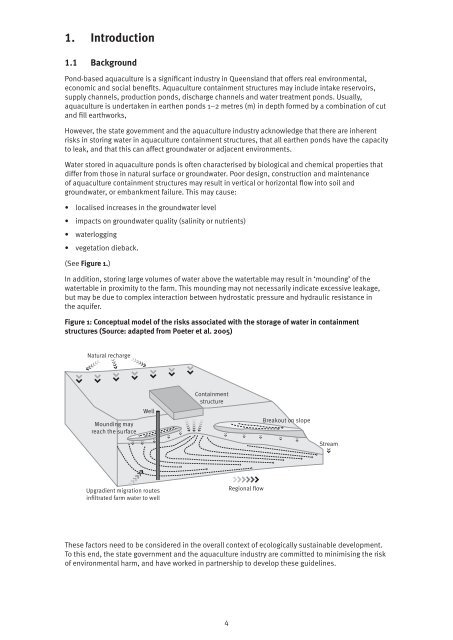Guidelines for constructing and maintaining aquaculture ...
Guidelines for constructing and maintaining aquaculture ...
Guidelines for constructing and maintaining aquaculture ...
Create successful ePaper yourself
Turn your PDF publications into a flip-book with our unique Google optimized e-Paper software.
1. Introduction<br />
1.1 Background<br />
Pond-based <strong>aquaculture</strong> is a significant industry in Queensl<strong>and</strong> that offers real environmental,<br />
economic <strong>and</strong> social benefits. Aquaculture containment structures may include intake reservoirs,<br />
supply channels, production ponds, discharge channels <strong>and</strong> water treatment ponds. Usually,<br />
<strong>aquaculture</strong> is undertaken in earthen ponds 1–2 metres (m) in depth <strong>for</strong>med by a combination of cut<br />
<strong>and</strong> fill earthworks,<br />
However, the state government <strong>and</strong> the <strong>aquaculture</strong> industry acknowledge that there are inherent<br />
risks in storing water in <strong>aquaculture</strong> containment structures, that all earthen ponds have the capacity<br />
to leak, <strong>and</strong> that this can affect groundwater or adjacent environments.<br />
Water stored in <strong>aquaculture</strong> ponds is often characterised by biological <strong>and</strong> chemical properties that<br />
differ from those in natural surface or groundwater. Poor design, construction <strong>and</strong> maintenance<br />
of <strong>aquaculture</strong> containment structures may result in vertical or horizontal flow into soil <strong>and</strong><br />
groundwater, or embankment failure. This may cause:<br />
• localised increases in the groundwater level<br />
• impacts on groundwater quality (salinity or nutrients)<br />
• waterlogging<br />
• vegetation dieback.<br />
(See Figure 1.)<br />
In addition, storing large volumes of water above the watertable may result in ‘mounding’ of the<br />
watertable in proximity to the farm. This mounding may not necessarily indicate excessive leakage,<br />
but may be due to complex interaction between hydrostatic pressure <strong>and</strong> hydraulic resistance in<br />
the aquifer.<br />
Figure 1: Conceptual model of the risks associated with the storage of water in containment<br />
structures (Source: adapted from Poeter et al. 2005)<br />
Natural recharge<br />
Mounding may<br />
reach the surface<br />
Well<br />
Containment<br />
structure<br />
Breakout on slope<br />
Stream<br />
Upgradient migration routes<br />
infiltrated farm water to well<br />
Regional flow<br />
These factors need to be considered in the overall context of ecologically sustainable development.<br />
To this end, the state government <strong>and</strong> the <strong>aquaculture</strong> industry are committed to minimising the risk<br />
of environmental harm, <strong>and</strong> have worked in partnership to develop these guidelines.<br />
4

















